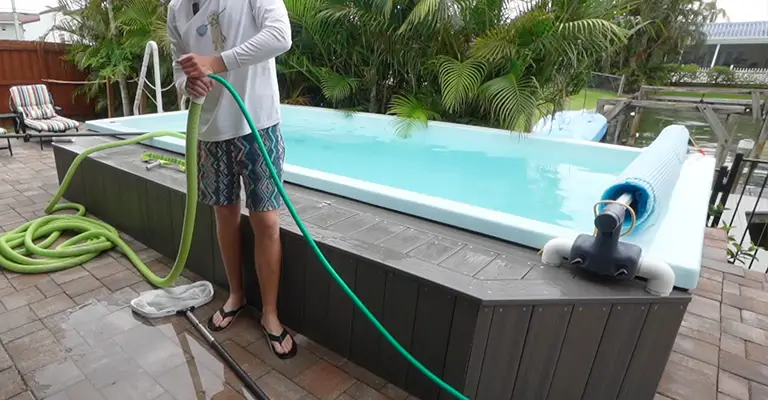Owning a pool comes with the joy of relaxation and recreation, but it also entails regular maintenance and care.
One familiar challenge pool owners face is dealing with water accumulation on the pool cover, especially after heavy rainfall or during the winter months.
While using a pump is the most efficient way to remove water from a pool cover, not everyone can access one. However, fear not! Alternative methods can help you tackle this issue without a pump.
American homeowners are faced with the dilemma of when to open their swimming pools every spring. Removing the pool cover is one of the most dreaded steps of the process.
As you put on your pool cover, you keep dirt and debris out of the water and accumulate debris on the surface. Water was the most common thing it gathered.
It is necessary to remove water from the cover before you can remove it. Using a pool cover pump is much more effective than squeezing the water out with a garden hose or scooping it with a bucket.
How can we remove this standing water from our covers when we don’t have a cover pump?
Water Accumulation
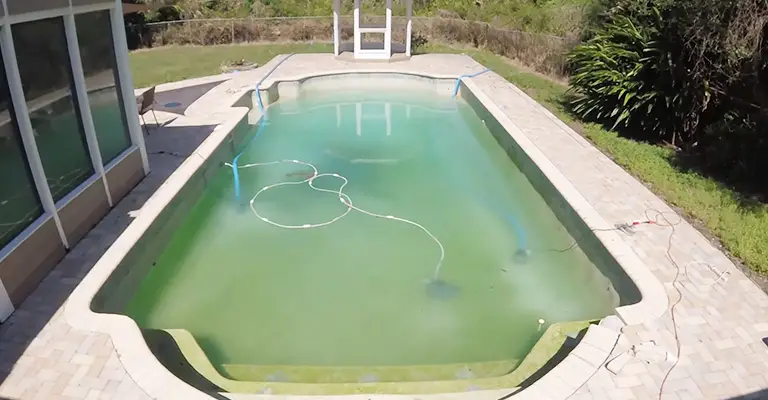
Swimming pool covers can become hazardous if they accumulate standing water. A pool cover could be torn, ripped, or sagged by simply water’s weight.
Furthermore, animals and young children that may gain access to the top of your pool may drown.
Keeping standing water away from your home is essential since it breeds algae and mosquitoes. Standing water should not be allowed to accumulate on swimming pool covers.
Garden Hose Siphon
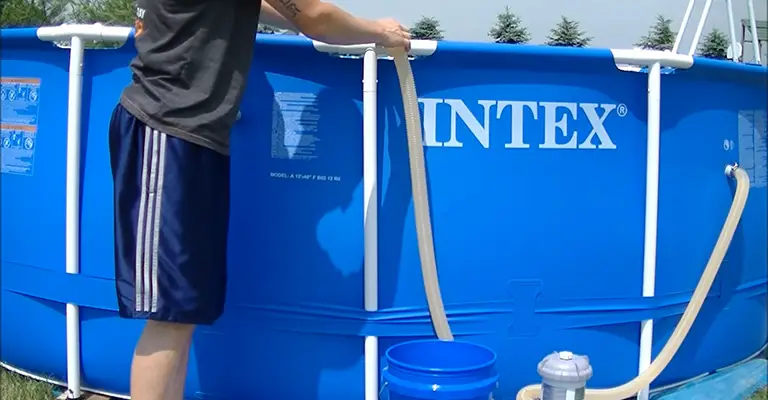
It is possible to fix this simply. Your standard garden hose can be used to do this, as well as your hose spigot and a brick. A long hose will be necessary to reach both the spigot and the pool cover.
Make sure the hose is pointing toward the standing water. Using a brick, secure it along the pool’s edge. Consequently, your hose will drain more slowly due to being slightly squashed. Attach the hose to the other end using your faucet’s end.
Make sure you turn on the faucet and let it run for approximately one minute. Act immediately by shutting off the water!
You can easily disconnect the hose end from the spigot by doing so quickly. As a result, a suction will be created that will start to pull water from your pool cover.
In some cases, the water may not drain completely. You should plan your layout accordingly since all the water will go wherever your faucet is.
Shop Vac
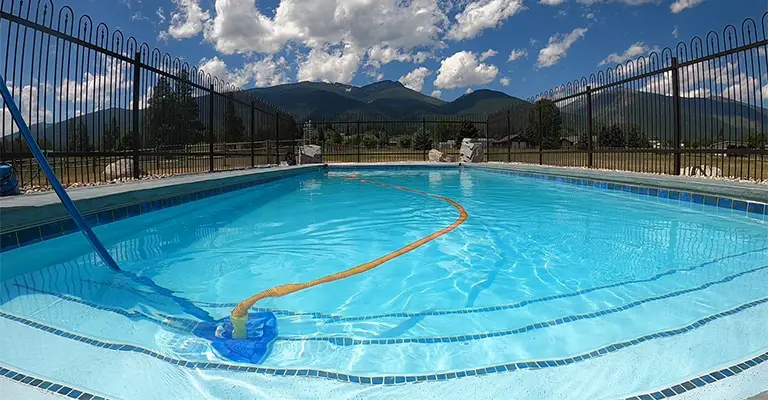
Shop vacs will work well to remove excess water from atop your pool cover. During this exercise, you will need to climb and balance.
There are limits to how much a shop vac can hold, so you may have to empty it more than once.
Be sure that your pool cover can withstand the combined weight of you and the vacuum before you try this. My gut feeling is that this is a risk I wouldn’t want to take.
Hire a Professional
I asked around to find out how much excess water would be removed when opening a pool. The risk of damage to the cover, while the water was on it, is why some companies won’t even consider it.
A couple of hundred bucks are what you’ll need if you can find a company. Other companies said they charge an hourly rate, while some said they charge a flat rate of $250.
This could be quite expensive, depending on what it is and how much water has accumulated. It is particularly important if you are also hiring a company to start up your swimming pool.
Cover Pumps
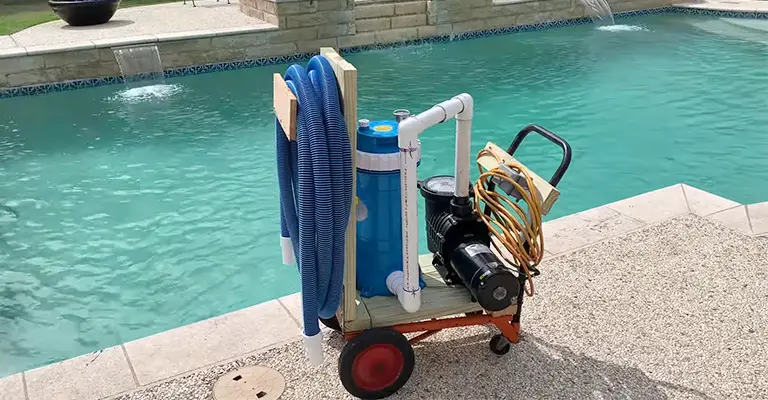
There is no better way to protect your house than a cover pump. Keep your water accumulation issue on track all winter long by using them.
As a result, there will be less risk of damaging your pool cover. As a result, opening the pool will be less challenging. Moreover, this prevents drowning, algal blooms, and mosquito bites.
Cover pumps are available both manually and automatically. Turning on or off the manual ones is your responsibility.
You can plug it in and forget about it using an automatic cover pump. They sense when the water levels reach a certain level and when to turn on and off.
How to Prevent Water From Collecting On Your Pool Cover
Even if water removal seems like something you do every season at the beginning of the season, if you live in a humid area, you should inspect your pool cover regularly.
It is important to keep your pool cover clean all year round and watch out for sagging caused by excess water collection.
You can quickly tell there is sagging whenever your pool cover dips in the center. Mold and mildew can form if pool covers dip. This can cause damage to pool walls and the formation of mildew.
Sagging occurs because of water weight, so keeping as much water off the cover as possible is a good practice.
Here are my top tips for preventing water from collecting on your pool cover:
Keep The Pool Center Higher Than The Sides
Gravity works half as hard if you adjust your cover to a sloping dome so that the center is higher than the sides.
In a properly constructed roof, water ought to flow off and collect on the sides to prevent the dreaded sagging in the center.
You could toss some rubber tires or inflated beach balls into the pool to distribute weight away from the center.
Ensure Proper Installation
When installing the pool cover, ensure it is tightly tightened and securely fastened. You might want to have a professional check it if you are unsure whether it has been done.
Fix And Adjust As Soon As Possible
Whenever you pass by your cover, check it and adjust the corners immediately if you see even the slightest sagging. A vital step to take following a storm is to clean up the area.
Weigh The Edges Down
You can reduce pool cover sagging by placing heavy water bags or pool pillows around their edges. If you want to create the best weight distribution in your pool, place the bags or another type of weight evenly along the pool’s edges.
When Should You Remove Rainwater From Your Pool Cover?
In addition to protecting the pool walls and the cover, ensure you do not allow rainwater or excess water to build up.
Additionally, pressure and moisture can build up, which can be harmful. There will be a build-up when at least two inches of water are on top of the cover, and you should remove the water.
Furthermore, it is important to regularly remove leaves and other debris from on top of the cover, which can weigh it down and cause damage to it.
Additionally, if it is cold outside, you should remove all the leaves so they will not freeze on top of the cover.
Safety reasons require this cover to have holes just in case someone gets stuck underneath and needs to breathe.
Due to these reasons, more water will also be able to seep through and will begin to accumulate from underneath the cover. This is why you should be able to maintain the cover’s moisture level.
As pool covers cannot withstand much weight, it is extremely important to inspect the build-up regularly because you may damage them and then have to replace them, which is not cost-effective.
Final Words
While removing all the excess water may seem like a difficult chore, especially when de-winterizing your house for summer, it isn’t that difficult. In most cases, you should use a pool cover pump because it handles most of the work.

